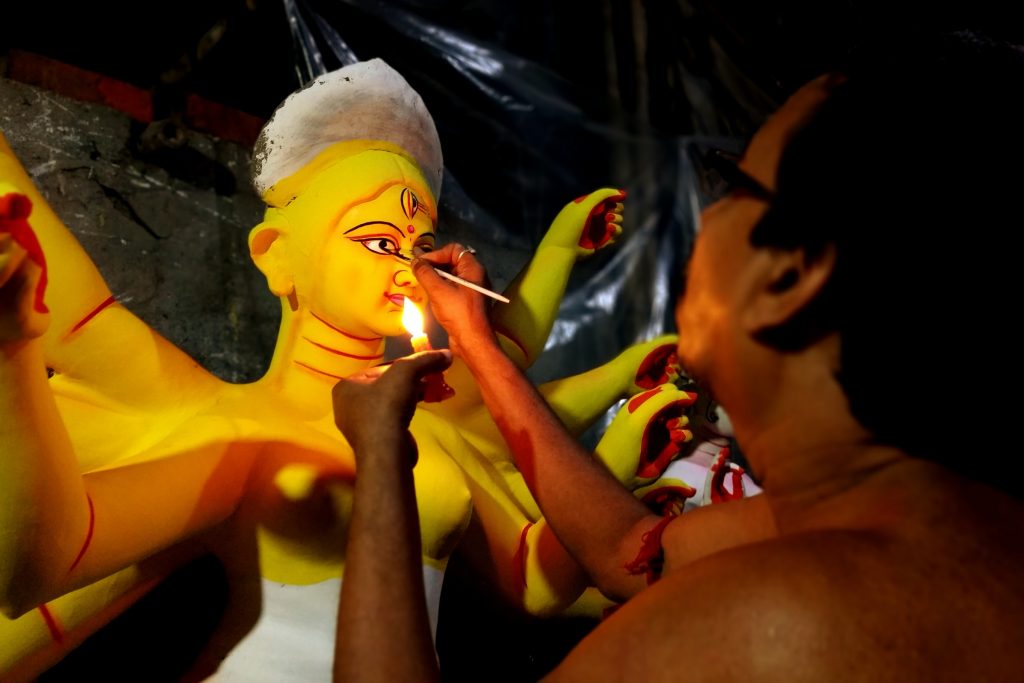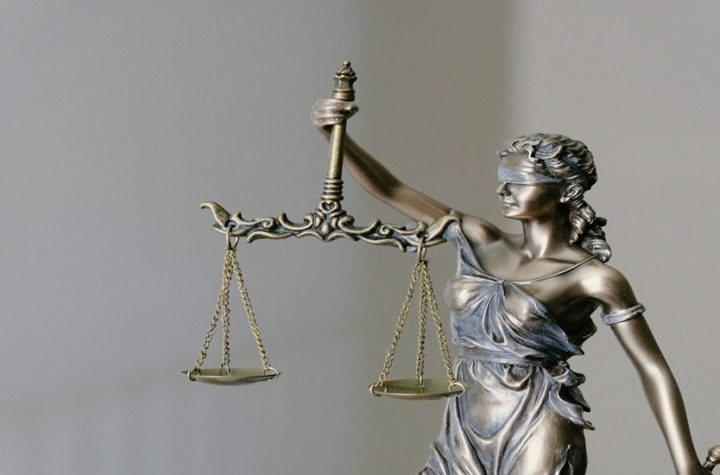
Durga Puja is one of the biggest festivals of India. It attracts millions of tourists from all across the world. This is not only a festival; it is a platform to see India and to know the socio-cultural traditions and trends of culture-rich India. This is the time when people meet with their friends and family. It is indeed a grand show of lighting, decor and one’s most unique creativity. It is celebrated in almost all the states of India. Each state has its own way to celebrate this festival.
Durga Puja has a unique way to celebrate in Eastern parts of India. West Bengal draws maximum attention for this. Here Goddess is worshiped in form of Mahisasurmardini – killer of demon Mahishasur. “Poojo” as it is referred here is biggest occasion for Bengalis. It starts from Mahalaya and goes on still Dashami. “Mahalaya” is the day when the Goddess is called on earth. On this day the environment becomes electrical with chants of Chandi Paath, hymns of the divine goddess. It is the last day of “Pitri-Paksha” and people offer tributes to ancestors. Banks of rivers host this great ritual. On this very day, eyes of goddess are carved on the idols. “Kumartuli” (Literally means locality of potters) is the place where the idols are made in huge numbers. These idols were even exported to foreign countries in large numbers. During these days, Kumartuli becomes an attraction for the all national and international tourists. Photographers love to take pictures of artisan giving shapes to grand idol of Goddess.
Actually, the state of West Bengal, celebrates the home coming of divine mother. The ritual goes likes Goddess Durga – referred as “Maa” by Bengalis – takes leave from Kailasa – her husband Lord Shiva’s place – and come to her father’s place on earth. This calls for huge food preparations – includes both veg and non veg items – at Bengali homes on eve of Maa’s home coming. Infact, here, the divine Goddess is considered as girl child of own house. One can even see the joy on people’s face on the first day of festival. At the same time one can notice tears rolling down the eyes of people on the last day while say bid-adieu to the divine mother for one year.
Dhakis, traditional drum players, are the stars during this period. They comprise of a group of drum players and one kashor, traditional metal beat player. During aarti, there is a procedure to offer respect to deity by pot of small fire. This called “Dhunuchi”, which is a traditional clay pot containing suppressed fire made out of coconut husk. Here, Dhakis, take up the show with the beats of drum. There is a tradition of “Dhunuchi dance” where people offer respect to the goddess by dancing and holding the dhunuchi in their hands with beats of Dhak.
Kolkata has got a lot of pandals – the places of worship – famous in their own way. Pandals of North Kolkata are famous for traditional way of worship and South Kolkata famous for lightings and decors. In addition to this, you will also a type called Bonedibari pujo, these are the worships done by families since times immemorial. These are done by family members and in authentic way.
There is a tradition of “Kumari Puja”, worshiping unmarried girls as a form of Goddess Durga. This acts a mark of respect for girl child. This is a tradition in Belur Maath, the headquarters of world famous Ramakrishna Mission. This tradition at Belur Math was started by Swami Vivekanand and acted a fantastic tool to overcome atrocities on women during that time. This tradition still goes on. This is the most unique way of worship the “Shakti” – the female power of universe. This attracts a lot of domestic and international tourists. It starts from the early morning.
Actuals days of the festival starts from Saptami, the seventh day of the festival. It is the day when millions of people are on roads to visit the pandals. The tour goes on 24 hours and also in nights. The lightings of the pandals and decorations are something worth mentioning. Astami, the eight day, is the biggest day of the festival. This is the day to offer Pushpanjali, tribute of flowers, to the deity. This is a special occasion when all members of the family, comes together to the pandals and offers flower accompanied with powerful hymns dedicated to the Goddess. The pandal hopping goes on till Navami, the ninth day of the festival. It is the day of maximum rush. These are the days when you will find the Bengalis in their best of the moods. This also calls for “Bhog” – a cooked food offering to the Goddess – and later distributed to devotes for consumptions. It is consisting of cooked rice, pulses, vegetables, chutney & payesh (Traditional Indian sweet accompaniments). There is concept of Sandhi Puja – Worship and rituals conducted at the juncture time of two days of festival. At this time 108 lotus flowers are offered to Goddess and 108 earthen lamps are lit. Dashami is the last day of the festival. This is the day when married ladies offer sindoor – red vermillion – and sweets to divine mother as a token to goodbye. Traditional dress for Bengali women for this occasion is “laal paar sada saree” – white saree (traditional Indian dress for women) with red borders. Married women offer Sindoor to other married women. This is popularly known as sindoor khela – play of red vermilion. This tradition is accompanied by beats of dhak with traditional dhunichi dance. This is followed by “Bishorjan” – the immersion ritual. In this ritual idol is immersed in the river water. This tradition acts as final goodbye to the divine goddess. People do this ritual with tear-filled eyes as divine mother leaves for one year. Idol is taken to middle of waterbody and seven “parikramas” – rotations – are done before immersions. (Please note: Authorities take utmost care & after immersion immediately lift the idol, using sophisticated machine, to prevent water pollution). The water in which the goddess is immersed is collected in earthen pots and considered as sacred. This is known as “Shanti-Jal” – water which gives peace. This is taken to houses by Bengalis and sprinkled to all corners with the help of mango leaves. This ritual is considered to bring peace at houses. Next comes the “Bijoya-Dashami” – celebration of victory on tenth day. Here people meet and visit each other’s houses – without any invite – to offer respect with show of harmony. Elder’s feet are touched to get their blessings. With youngers and for same age “kula-kuli” is done – hugging each other thrice as show of love and affection. Needless to say, no occasion of Bengalis gets complete without offering of sweets to each other.
During this time restaurants of the Kolkata witness the busiest time. People love to taste the traditional Bengali food served in authentic way. Park Street, the restaurant zone of Kolkata sees the largest footfall. Also, different hotels of the city arranges different food festival in the different outlets.
Apart from West Bengal different Indian State celebrates this festival in different way. In Gujarat, it is more commonly known as “Navratri”, the festival of nine nights. The play of Garbha, a traditional Indian dance with small sticks, is worth mentioning. This continues through the night.
Durga Puja is celebrated in a grand way in the Indian State of Karnataka. In Mysore, “Dussehra”, as it is known as, is the most popular festival. In this occasion royal elephants are dressed with robes and jewelries and taken out in processions through the streets of the city. In fact, many people visit Mysore from all over the country to watch this colorful event. There is also a floating festival in the temple tank at the foot of Chamundi Hill and a procession of chariots around the temple at the top.
State of Jammu and Kashmir celebrate their festivals with pomp and show. Here people worship Lord Shiva and Goddess Sherawali, the Goddess who rides the tiger (also, a form of Goddess Durga). Each Hindu household does the worship at home. All the adult members of the household fast on water. In the evenings, fruit may be taken. Kashmiris grow barley in earthen pots. They believe that if the growth in this pot is good, there is prosperity all year. The most important ritual for Kashmiri Pandits is to visit the temple of guardian goddess “Kheer Bhawani” on all nine days. On the last day of Navratri, aarti, a form of worship with fire, is held at the temple, after which people break their fast. On Dussehra, the tenth day of the festival, Demon Ravana‘s effigy is burnt.
In Kerala, Durga Puja signifies the beginning of formal education for every child. While puja goes on in the temple for all ten days, it is the concluding three days which are most important. Ashtami is the day of Ayudya Puja, when all the tools at home are worshipped. Custom dictates that no tools be used on this day. On Navami day, Goddess Saraswati is honored by worshipping the books and records at home. Thousands of devoties visit the Saraswati temple at Kottayam during this period to take a dip in the holy pond, whose source is yet unknown. Large gatherings are also seen at the famous temples at Thekkegram (Palghat), in which there are no idols, only huge mirrors. A devotee finds himself bowing before his own reflection, which symbolizes that God is within us. Thrikkavu Temple a famous Durga Devi Temple at Ponnani, Malapuram District of Kerala, is also famous for Navaratri festival and Vdyarambham (beginning of formal education). Thousands of children throng this temple on Vijaya Dasami day for vidyarambham.
In Maharastra, Puja is performed each day and devotees offer flower garland each day on the idol or image of the deity. After nine days, all nine garlands are removed together. An elephant is drawn with rangoli, and the girls play guessing games. It is called as ‘bhodala’ Then they are fed a meal of their choice.
In Goa great festivities take place in all the temples. People fast and observe festivities at home.
In Delhi, there are more than 800 registered pujas, which are celebrated with great fanfare by Bengalis living in the city. The oldest Durga Puja, started in 1910, is popularly known as the Kashmir Gate Puja.
Durga Puja is celebrated in the state of Andhra Pradesh at Hyderabad and Vijayawada with all its pride and glory. The temple in Vijayawada is located adjacent to Krishna River and near to Prakasham Barrage. This temple is one of the biggest devotees place in South India. In Hyderabad, Durga Puja is being celebrated for more than 60 years now. There are 5 major organization that celebrate the puja across the city.
Durga Puja is not just a festival in India. It is show of rich culture and tradition.




More Blogs
UPI And Pay Now Integration
India Australia Trade Agreement – An Analysis !
5G & Impact On Business